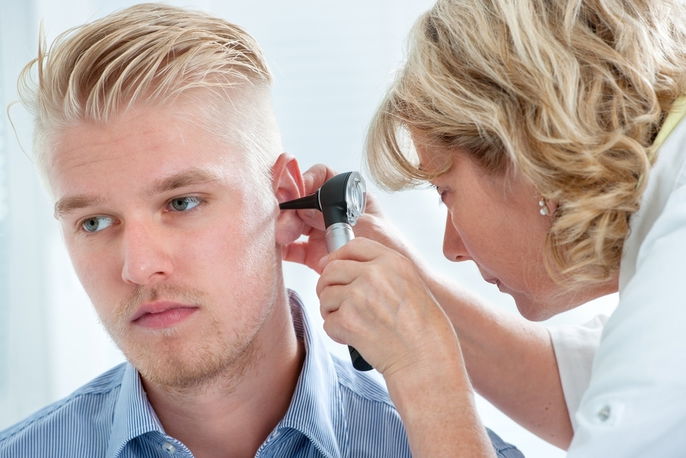Ear discharge, also known as otorrhea, is a common symptom that can occur due to a variety of underlying conditions. It may be linked to ear infections, ear drum damage, or even head injuries, causing discomfort and potential complications if left untreated.
The appearance of ear discharge can vary, with common colors being clear, yellow, or white, but it may also become red if related to injury. In some cases, the discharge may have a foul smell, indicating a bacterial infection, which requires prompt medical attention.
Treatment for ear discharge depends on the underlying cause, ranging from antibiotics for infections to specialized care for conditions like cholesteatomas or foreign objects in the ear. A timely visit to a healthcare provider can help determine the cause and appropriate treatment, preventing further complications.

What causes ear discharge?
The main causes of ear discharge are:
1. Ear infection
An ear infection can occur in the middle ear (otitis media) or inner ear (otitis interna). They are associated with inflammation in the middle or inner ear, which is caused by bacteria, viruses, or in rarer cases, fungus. Infection can also emerge following trauma or allergies. Symptoms include pain within the ear, yellow or white that is foul-smelling, hearing loss and fever.
Ear infections are more common in babies and children, and symptoms in these patients may be more difficult to identify. If a baby has a fever, is agitated and is persistently pulling at their ear, the child should be assessed by a pediatrician, as it may be a sign of an ear infection.
How to treat: Treatment consists of analgesic and anti-inflammatory medications to help manage symptoms. Bacterial ear infections may require antibiotics. Check-out home remedies for an ear infection that can complement your medical treatment.
2. Foreign bodies
Foreign bodies can be become lodged in the ear canal accidentally or intentionally by children. The objects that most commonly become stuck in the ear are small toes, buttons, insects or foods. They can cause pain, itching and ear discharge.
How to treat: A health care professional can remove the foreign body by using tweezers or a suction machine. Severe cases of lodged objects may require surgical removal.
3. Swimmer’s ear
Swimmer’s ear is characterized by inflammation of the ear canal, which connects the external ear to the ear drum. It is associated with symptoms like pain, itching, fever and yellow or white discharge with a foul-odor. Common causes of this condition are exposure to heat and moisture and cotton swab use.
How to treat: Treatment of swimmer’s ear may consist of cleansing of the ear with saline or alcohol solutions. The doctor may recommend ear drops to treat infection and inflammation, as well as antibiotics like ciprofloxacin.
If the ear drum becomes perforated, other medications may be necessary. Because swimmer’s ear can cause pain and inflammation, the doctor may also recommend analgesics or anti-inflammatories.
4. Mastoiditis
Mastoiditis is an inflammation of the mastoid bone behind the ear. It can occur as a result of an untreated ear infection, in which bacteria spreads and reaches the mastoid bone. This inflammation can cause symptoms like redness, swelling, pain, fever and yellow ear discharge. In more serious cases, an abscess can form or the mastoid bone can break down.
How to treat: Generally, treatment involves the use of IV antibiotics like ceftriaxone and vancomycin for 2 weeks. In more serious cases that do not respond with antibiotics, drainage or surgical intervention may be necessary.
5. Head injury
Severe head injuries, like an electric shock or skull fractures, can cause ear discharge that may be blood-tinged.
How to treat: This type of head injury is a medical emergency and should be urgently assessed.
6. Ear drum rupture
The ear drum is a thin membrane that separates the inner ear from the middle ear. A perforation in this membrane can cause pain, itching, hearing loss, bleeding and ear discharge. Signs and symptoms that occur during a rupture include itching, intense pain, buzzing, dizziness, vertigo and yellow ear discharge.
How to treat: Usually, a small perforation can heal on its own within a few weeks to months. During this time, the ear should be covered when bathing, and the beach or pool should be avoided.
7. Cholesteatoma
A cholesteatoma consists of a benign growth in the middle ear, behind the ear drum. It is generally caused by repetitive, chronic ear infections, or it may be a congenital finding.
In its initial stages, it can cause a foul.smelling ear discharge, but as it starts to grow, it can cause pressure within the eat. This can cause discomfort and lead to more serious problems, like breakdown of the middle ear bones, hearing loss, balance issues, and loss of facial muscle movement.
How to treat: The only way to treat this problem is through surgery. It is often recommended to prevent more serious complications. Surgery is usually followed up by regular assessments to ensure it has not returned.






























